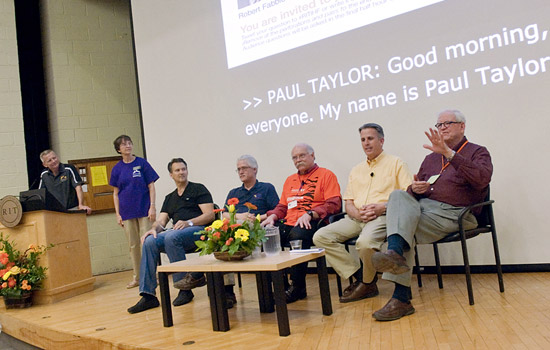Innovation Hall of Famers share inspirations
2013 RIT Innovation Hall of Famers give panel discussion
Mark Benjamin
An informal panel discussion with the RIT Innovation Hall of Fame inductees was held during Saturday’s Imagine RIT: Innovation and Creativity Festival.
When Paul Taylor visited the World’s Fair in 1964, he saw a videophone. He tried it out, and because he and his wife, Sally, are deaf, it was the first time they were able to communicate from different rooms. What had been previously impossible for them planted the seed for early developments into a telecommunication device for the deaf that Taylor helped launch, and helped establish a national network of users and relay services.
“To just see the shock and reaction by all the people, and to be able to provide telephone communication to them for the first time,” he said.
Taylor, who taught engineering at RIT’s National Technical Institute for the Deaf from 1975 to 2005, recalled those memories during an informal panel discussion with other RIT Innovation Hall of Fame inductees during Saturday’s Imagine RIT: Innovation and Creativity Festival.
Taylor, who received an engineering degree without the assistance of interpreters, said it bothered him that deaf people didn’t have access to phone communication for many years. He said the inability to use a phone not only was discouraging for work, it affected his social life, too. “It’s not great when you have to ask your mother to call a girl for you.”
Fellow inductee Lynn Fuller, founder of RIT’s microelectronic engineering program, said he keeps inspired by learning something new every day. And he enjoys an uninterrupted 35-minute commute to and from work to simply think.
John Schott, a professor in RIT’s Chester F. Carlson Center for Imaging Science and a founder of the imaging science program, said he keeps motivated by the things he doesn’t understand.
Inductee Jackie Pancari, a glass artist from Allegany County, said she finds inspiration in things she sees around her.
Bruce Smith, director of RIT’s microsystems engineering program and professor of electrical engineering, said he enjoys the challenge of the unknown, and the curiosity of young people on the RIT campus.
And Robert Fabbio, a 1985 computer science graduate from RIT who is a serial entrepreneur and CEO of WhiteGlove Health in Austin, Texas, said there are three types of change: evolutionary, revolutionary and disruptive. He said making money is important for every business, but it doesn’t validate innovation. “Validation just happens. Sometimes you make money and sometimes you don’t,” he said.
Fuller said he tells his students he expects they will fail in their first attempts at creating something innovative. But they should learn from those mistakes and persevere. “Even if you are on the right track, you can get run over if you don’t keep moving fast enough.”
RIT Provost Jeremy Haefner thanked the inductees for their innovative contributions. “We’re so proud to have you as a part of RIT,” he said.














